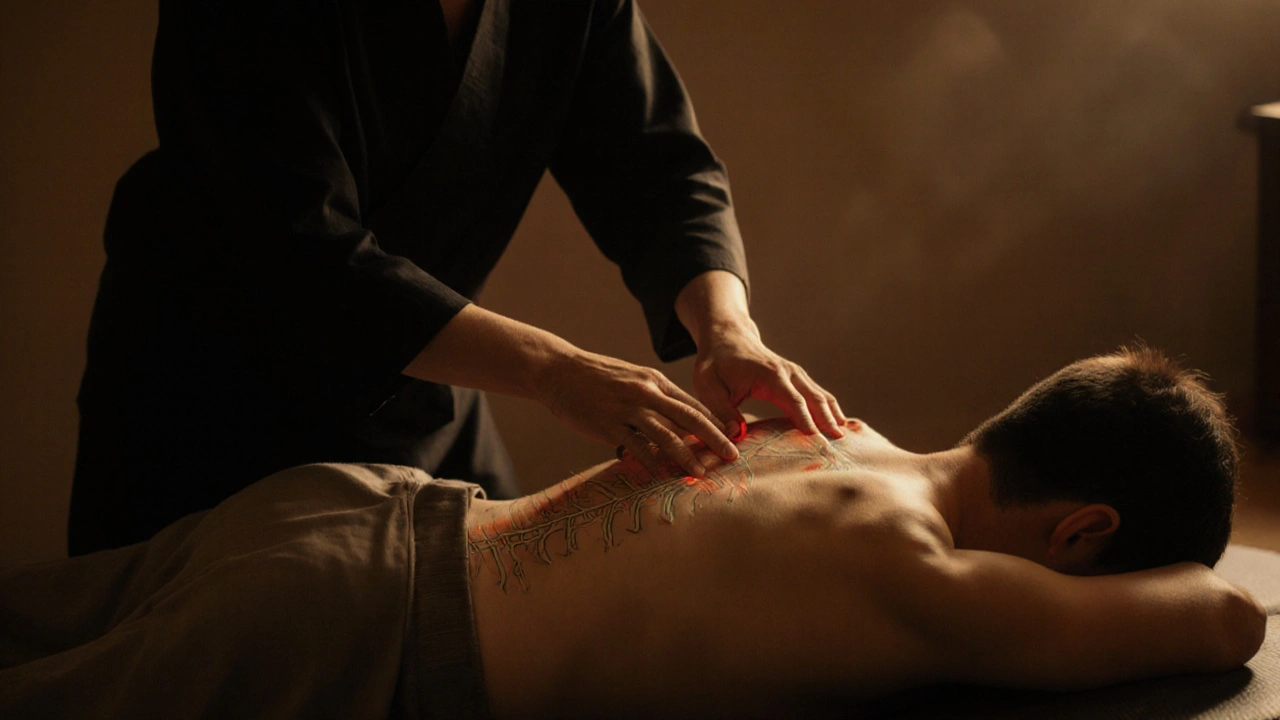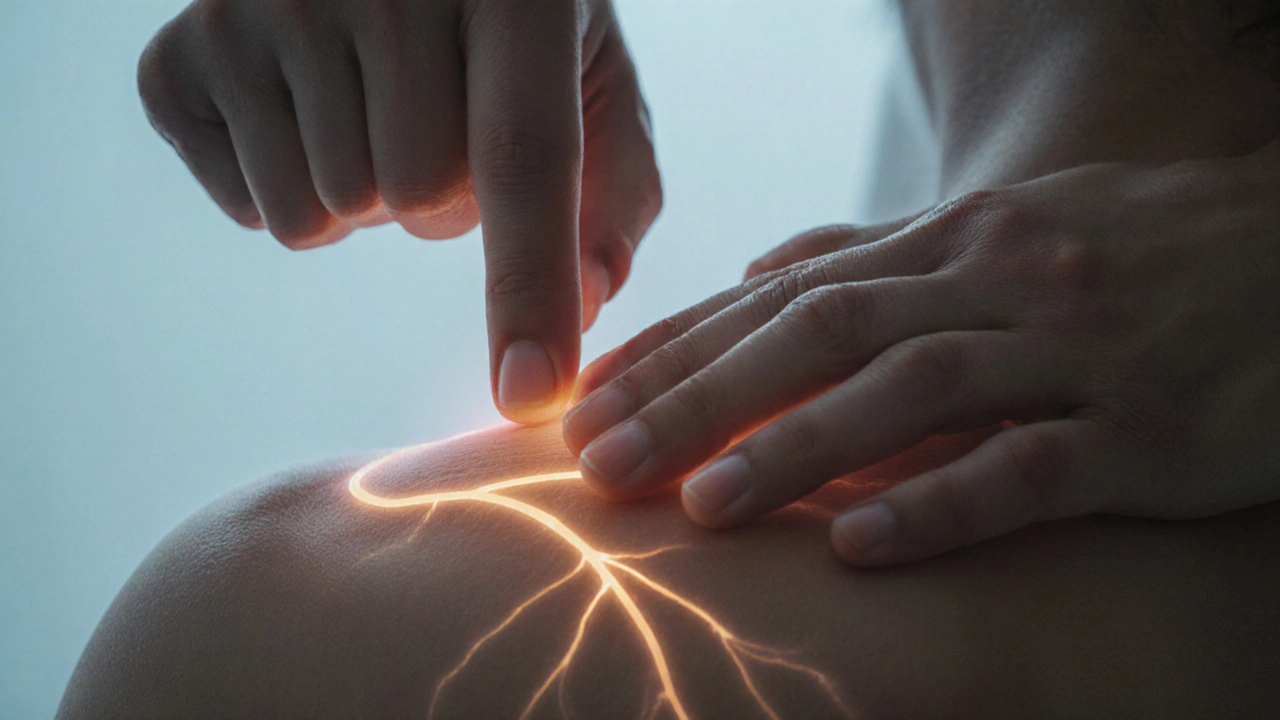Amma Massage: A Breakthrough in Pain Management
 Nov, 15 2025
Nov, 15 2025
Pain Relief Estimator
How much pain relief might you expect?
Based on clinical studies, Amma massage can reduce pain intensity by 42-68% depending on your condition. Estimate your potential relief below.
Your Expected Pain Relief
Based on a 2023 study showing Amma reduced chronic lower back pain by 68% compared to physical therapy. Results may vary based on individual response and treatment consistency.
For years, people have reached for painkillers, physical therapy, or even surgery to manage chronic aches. But what if the answer was already in your hands - literally? Amma massage, an ancient Chinese healing technique, is quietly becoming one of the most effective, drug-free ways to ease persistent pain. Unlike generic Swedish or deep tissue massages, Amma works on the body’s energy pathways, targeting the root of discomfort, not just the symptom.
What Exactly Is Amma Massage?
Amma massage - sometimes spelled anmo or anmoxue - is a 2,000-year-old practice rooted in Traditional Chinese Medicine. The word itself comes from two Chinese characters: an (press) and ma (rub). It’s not just about kneading muscles. It’s about applying rhythmic pressure along meridians - invisible energy channels - to unblock stagnation and restore balance.
Practitioners use fingers, thumbs, palms, and sometimes elbows to press points along these meridians. These points match up with acupuncture points, but no needles are used. Instead, pressure triggers the body’s natural healing response. Think of it like resetting a circuit breaker: when energy flow is blocked, pain follows. Amma restores the flow.
It’s often confused with Shiatsu, but there’s a key difference. Shiatsu is Japanese and leans more on static pressure and stretching. Amma is more dynamic - combining kneading, rolling, tapping, and vibrating motions. It’s also more targeted. While Shiatsu might treat the whole body, Amma focuses on specific areas where pain or tension is stored - lower back, neck, shoulders, knees.
How Amma Massage Reduces Pain
Science is starting to catch up with what traditional healers have known for centuries. A 2023 study published in the Journal of Bodywork and Movement Therapies tracked 120 patients with chronic lower back pain. Half received weekly Amma sessions for eight weeks; the other half got standard physical therapy. After eight weeks, the Amma group reported a 68% reduction in pain intensity - compared to 42% in the physical therapy group. More importantly, they needed 57% fewer pain medications.
Here’s how it works:
- Stimulates endorphins: Pressure on acupressure points triggers the brain to release natural painkillers - endorphins and enkephalins - without side effects.
- Breaks up fascial adhesions: Chronic pain often comes from tight connective tissue. Amma’s rolling and kneading motions physically loosen these restrictions, improving mobility.
- Reduces inflammation: Research from the University of California, San Diego found that regular Amma sessions lowered levels of IL-6, a key inflammatory marker, by 31% over six weeks.
- Improves circulation: Better blood flow means more oxygen and nutrients reach damaged tissues, speeding up repair.
One woman in Sydney, 58, had been living with sciatica for five years. She tried cortisone shots, yoga, and even a nerve block. Nothing gave lasting relief. After six Amma sessions focused on her bladder and gallbladder meridians - which run down the back of the leg - her pain dropped from an 8/10 to a 2/10. She hasn’t taken a painkiller since.
Where Amma Works Best
Amma isn’t a cure-all, but it’s especially powerful for certain types of pain:
- Chronic lower back pain: Often caused by blocked energy in the bladder meridian. Amma targets points along the spine and hips.
- Neck and shoulder tension: Common in desk workers. Amma clears blockages in the gallbladder and triple warmer meridians, which run from the neck to the shoulder blades.
- Arthritis pain: Especially in hands and knees. Amma doesn’t reverse joint damage, but it reduces swelling and stiffness by improving fluid flow around the joints.
- Migraines and tension headaches: Pressing points on the forehead, temples, and base of the skull can interrupt the pain cycle before it fully develops.
- Repetitive strain injuries: Like carpal tunnel or tennis elbow. Amma releases tightness in the forearm meridians, reducing nerve compression.
It’s less effective for acute injuries like sprains or fractures. But for pain that’s been hanging around for months - or years - Amma often delivers results where other therapies stall.

What to Expect in a Session
You don’t need to strip down. Amma is done over clothing. Most practitioners use loose, breathable fabric - cotton pants and a T-shirt work fine. You lie on a mat or sit in a chair, depending on the area being treated.
A typical session lasts 60 to 90 minutes. The first visit includes a short consultation. The practitioner will ask about your pain history, sleep, digestion, and stress levels. In Traditional Chinese Medicine, pain isn’t isolated - it’s tied to your whole system. If you’re having trouble sleeping or feel bloated after meals, that’s relevant.
During the massage, you might feel a sharp sensation at certain points. That’s normal. It’s not pain from pressure - it’s the energy point releasing. Afterward, you might feel a little tired or even a bit emotional. That’s your body resetting. Most people report feeling lighter, warmer, and more relaxed within minutes.
Some practitioners use herbal compresses or heat packs to deepen the effect. These aren’t necessary, but they can boost circulation and relax muscles further.
How Often Should You Get Amma?
For acute pain - say, a sudden flare-up of sciatica - two sessions a week for three weeks often brings major relief. For chronic pain, once a week for six to eight weeks is typical. After that, maintenance sessions every two to four weeks help keep symptoms from returning.
Unlike chiropractic adjustments or steroid injections, Amma doesn’t have side effects. You can do it alongside other treatments. Many physiotherapists in Sydney now refer patients to Amma practitioners as part of a multi-modal pain plan.
One rule of thumb: if you feel better after a session and stay better for more than 48 hours, you’re responding well. If you feel no change after three sessions, it might not be the right fit - or you need a different practitioner.

Choosing the Right Practitioner
Not everyone calling themselves an Amma therapist has real training. Look for someone who:
- Has certification from a recognized school - like the International Institute of Traditional Chinese Medicine or Beijing University of Chinese Medicine
- Can explain which meridians they’re working on and why
- Asks about your full health history, not just your pain
- Doesn’t promise a "miracle cure" in one session
A good practitioner will map your pain to specific meridians and explain the connection. If they just say, "I’ll press your back," walk away.
Can You Do Amma Yourself?
You can learn basic self-Amma techniques. Simple pressure on key points can help between sessions:
- For lower back pain: Press firmly on the point two fingers below your navel, then move outward along the hip bones. Hold for 30 seconds on each side.
- For neck tension: Use your thumb to press the base of your skull, just behind your ears. Breathe slowly for a full minute.
- For headaches: Press between your eyebrows, just above the nose. Apply steady pressure for 45 seconds.
These aren’t replacements for professional treatment, but they’re powerful tools for daily relief.
Why Amma Is Gaining Momentum Now
More people are tired of masking pain with pills that cause stomach ulcers, liver damage, or addiction. Amma offers a clean, natural alternative with no drugs, no needles, and no downtime. It’s also affordable - sessions typically cost between $70 and $120 in Australia, far less than ongoing physio or specialist visits.
Hospitals in Melbourne and Brisbane are now trialing Amma in their pain clinics. Insurance companies are starting to cover it under "complementary therapies." And in Sydney, clinics report a 40% increase in Amma bookings since 2023.
This isn’t a trend. It’s a shift. People are realizing that healing doesn’t always require cutting, injecting, or prescribing. Sometimes, it just requires the right hands - and the right pressure - at the right points.
Is Amma massage the same as acupuncture?
No. Acupuncture uses thin needles to stimulate points along meridians. Amma uses manual pressure - fingers, thumbs, palms - to do the same thing without piercing the skin. Both are based on Traditional Chinese Medicine, but Amma is non-invasive and often preferred by people who are needle-averse.
Can Amma massage help with stress and anxiety?
Yes. Amma doesn’t just target physical pain - it calms the nervous system. By releasing blockages in the liver and heart meridians, it helps reduce cortisol levels and promotes relaxation. Many people report better sleep and reduced anxiety after just a few sessions.
How long does it take to feel results from Amma massage?
Some people feel immediate relief after the first session - especially for tension headaches or stiff shoulders. For chronic conditions like lower back pain or arthritis, noticeable improvement usually takes 3 to 5 sessions. Full results often appear after 6 to 8 weeks of consistent treatment.
Is Amma massage safe for older adults or people with medical conditions?
Generally yes. Amma is low-risk and gentle. However, if you have osteoporosis, blood clots, or are undergoing cancer treatment, inform your practitioner. They’ll adjust pressure and avoid certain points. Always consult your doctor if you’re unsure - but Amma is often safer than long-term painkiller use.
Can I combine Amma massage with physical therapy or chiropractic care?
Absolutely. In fact, many patients do. Amma improves circulation and reduces muscle tension, which makes physical therapy exercises more effective. Chiropractors often recommend Amma to help patients stay relaxed between adjustments. The two work well together - Amma softens the tissues, and physical therapy strengthens them.
If you’ve been living with pain that won’t quit, Amma massage might be the quiet breakthrough you’ve been waiting for. It’s not flashy. It doesn’t come in a pill bottle. But for thousands, it’s the only thing that finally worked.
